Analyzing the Controversy: Marijuana Legalization for Recreation
VerifiedAdded on 2023/04/10
|7
|1545
|317
Essay
AI Summary
This essay presents a debate against the legalization of marijuana for both medical and recreational purposes, despite acknowledging its potential medicinal benefits. It argues that the potential health hazards, addictive nature, and risk of creating a large-scale commercialized marijuana industry outweigh the purported advantages. The essay highlights concerns about brain tissue damage, increased mental health issues, and the vulnerability of teenagers to addiction. While acknowledging the rising public support for legalization and the legal cannabis movement in countries like Canada and Mexico, the essay emphasizes the lack of comprehensive evidence regarding marijuana's medicinal uses and the potential for abuse, referencing its classification as a Schedule I drug under the Controlled Substances Act. The essay concludes that the significant gap in knowledge and the risks associated with marijuana use make its legalization highly doubtful.
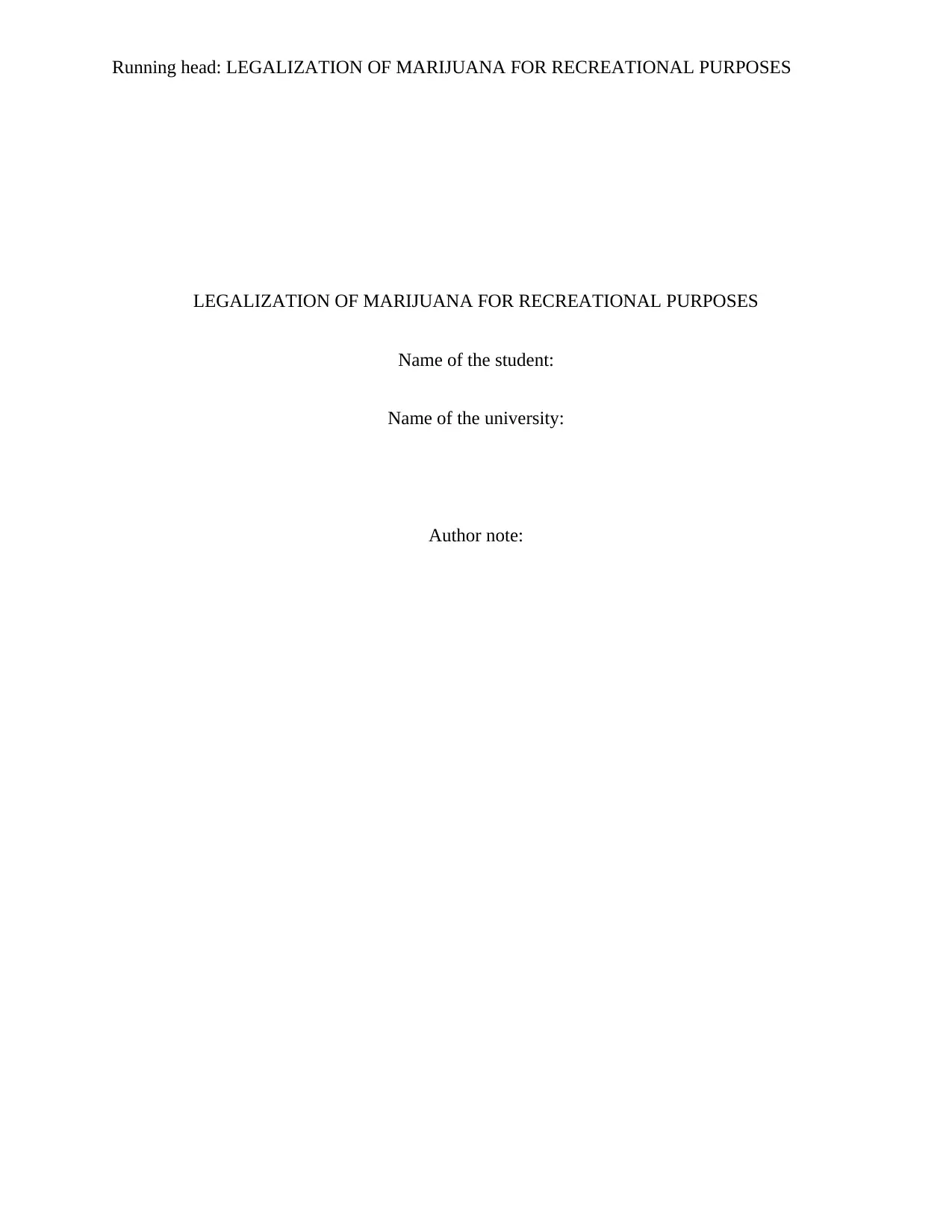
Running head: LEGALIZATION OF MARIJUANA FOR RECREATIONAL PURPOSES
LEGALIZATION OF MARIJUANA FOR RECREATIONAL PURPOSES
Name of the student:
Name of the university:
Author note:
LEGALIZATION OF MARIJUANA FOR RECREATIONAL PURPOSES
Name of the student:
Name of the university:
Author note:
Paraphrase This Document
Need a fresh take? Get an instant paraphrase of this document with our AI Paraphraser
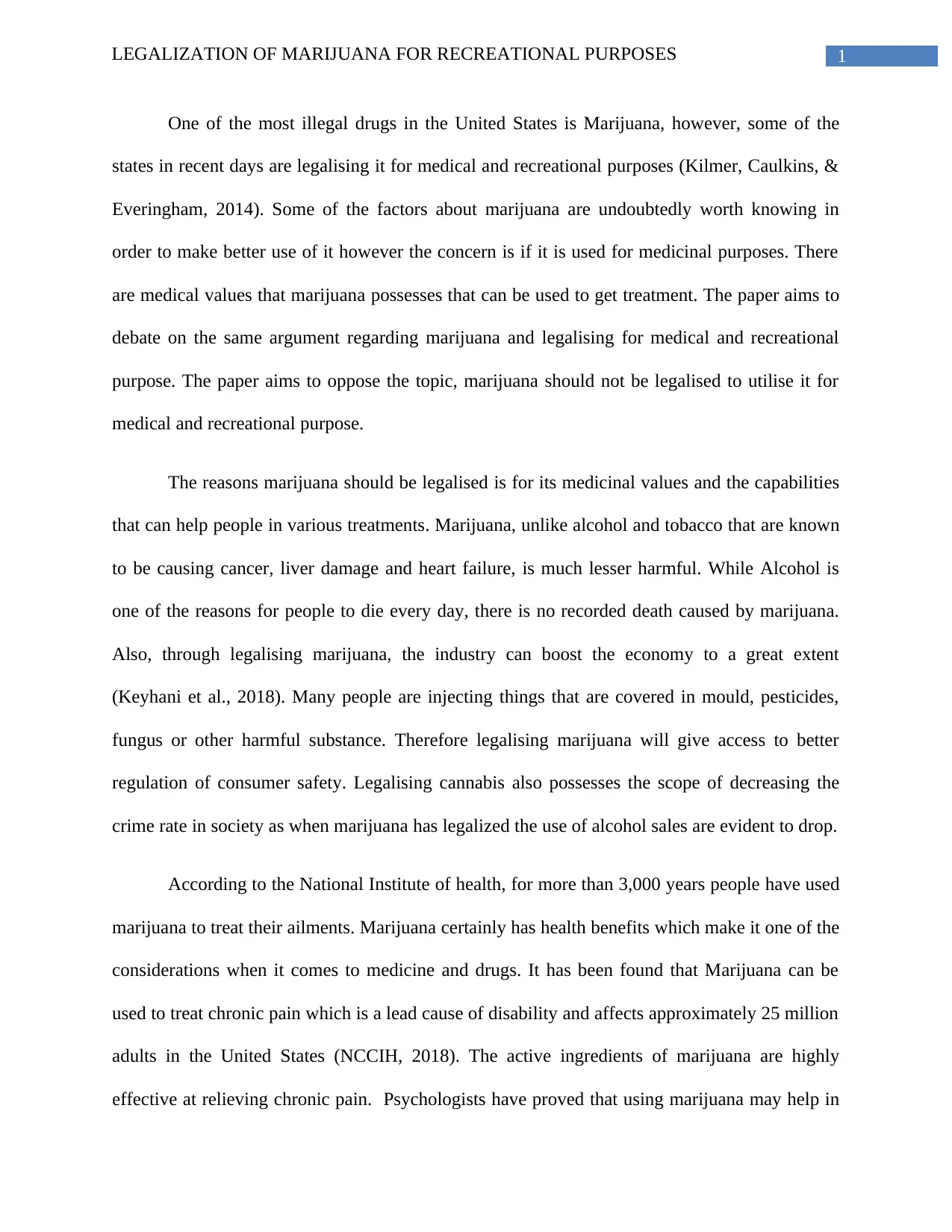
1LEGALIZATION OF MARIJUANA FOR RECREATIONAL PURPOSES
One of the most illegal drugs in the United States is Marijuana, however, some of the
states in recent days are legalising it for medical and recreational purposes (Kilmer, Caulkins, &
Everingham, 2014). Some of the factors about marijuana are undoubtedly worth knowing in
order to make better use of it however the concern is if it is used for medicinal purposes. There
are medical values that marijuana possesses that can be used to get treatment. The paper aims to
debate on the same argument regarding marijuana and legalising for medical and recreational
purpose. The paper aims to oppose the topic, marijuana should not be legalised to utilise it for
medical and recreational purpose.
The reasons marijuana should be legalised is for its medicinal values and the capabilities
that can help people in various treatments. Marijuana, unlike alcohol and tobacco that are known
to be causing cancer, liver damage and heart failure, is much lesser harmful. While Alcohol is
one of the reasons for people to die every day, there is no recorded death caused by marijuana.
Also, through legalising marijuana, the industry can boost the economy to a great extent
(Keyhani et al., 2018). Many people are injecting things that are covered in mould, pesticides,
fungus or other harmful substance. Therefore legalising marijuana will give access to better
regulation of consumer safety. Legalising cannabis also possesses the scope of decreasing the
crime rate in society as when marijuana has legalized the use of alcohol sales are evident to drop.
According to the National Institute of health, for more than 3,000 years people have used
marijuana to treat their ailments. Marijuana certainly has health benefits which make it one of the
considerations when it comes to medicine and drugs. It has been found that Marijuana can be
used to treat chronic pain which is a lead cause of disability and affects approximately 25 million
adults in the United States (NCCIH, 2018). The active ingredients of marijuana are highly
effective at relieving chronic pain. Psychologists have proved that using marijuana may help in
One of the most illegal drugs in the United States is Marijuana, however, some of the
states in recent days are legalising it for medical and recreational purposes (Kilmer, Caulkins, &
Everingham, 2014). Some of the factors about marijuana are undoubtedly worth knowing in
order to make better use of it however the concern is if it is used for medicinal purposes. There
are medical values that marijuana possesses that can be used to get treatment. The paper aims to
debate on the same argument regarding marijuana and legalising for medical and recreational
purpose. The paper aims to oppose the topic, marijuana should not be legalised to utilise it for
medical and recreational purpose.
The reasons marijuana should be legalised is for its medicinal values and the capabilities
that can help people in various treatments. Marijuana, unlike alcohol and tobacco that are known
to be causing cancer, liver damage and heart failure, is much lesser harmful. While Alcohol is
one of the reasons for people to die every day, there is no recorded death caused by marijuana.
Also, through legalising marijuana, the industry can boost the economy to a great extent
(Keyhani et al., 2018). Many people are injecting things that are covered in mould, pesticides,
fungus or other harmful substance. Therefore legalising marijuana will give access to better
regulation of consumer safety. Legalising cannabis also possesses the scope of decreasing the
crime rate in society as when marijuana has legalized the use of alcohol sales are evident to drop.
According to the National Institute of health, for more than 3,000 years people have used
marijuana to treat their ailments. Marijuana certainly has health benefits which make it one of the
considerations when it comes to medicine and drugs. It has been found that Marijuana can be
used to treat chronic pain which is a lead cause of disability and affects approximately 25 million
adults in the United States (NCCIH, 2018). The active ingredients of marijuana are highly
effective at relieving chronic pain. Psychologists have proved that using marijuana may help in
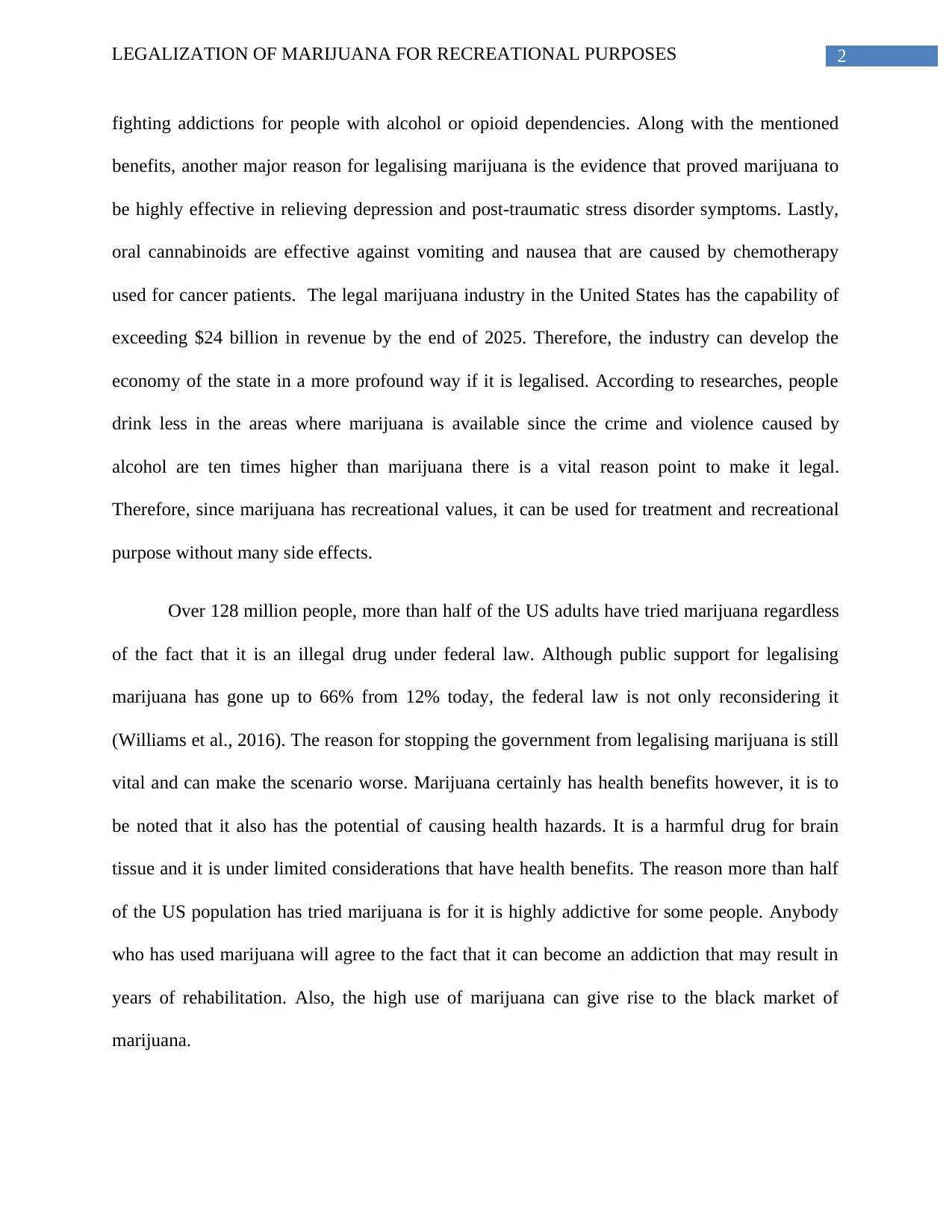
2LEGALIZATION OF MARIJUANA FOR RECREATIONAL PURPOSES
fighting addictions for people with alcohol or opioid dependencies. Along with the mentioned
benefits, another major reason for legalising marijuana is the evidence that proved marijuana to
be highly effective in relieving depression and post-traumatic stress disorder symptoms. Lastly,
oral cannabinoids are effective against vomiting and nausea that are caused by chemotherapy
used for cancer patients. The legal marijuana industry in the United States has the capability of
exceeding $24 billion in revenue by the end of 2025. Therefore, the industry can develop the
economy of the state in a more profound way if it is legalised. According to researches, people
drink less in the areas where marijuana is available since the crime and violence caused by
alcohol are ten times higher than marijuana there is a vital reason point to make it legal.
Therefore, since marijuana has recreational values, it can be used for treatment and recreational
purpose without many side effects.
Over 128 million people, more than half of the US adults have tried marijuana regardless
of the fact that it is an illegal drug under federal law. Although public support for legalising
marijuana has gone up to 66% from 12% today, the federal law is not only reconsidering it
(Williams et al., 2016). The reason for stopping the government from legalising marijuana is still
vital and can make the scenario worse. Marijuana certainly has health benefits however, it is to
be noted that it also has the potential of causing health hazards. It is a harmful drug for brain
tissue and it is under limited considerations that have health benefits. The reason more than half
of the US population has tried marijuana is for it is highly addictive for some people. Anybody
who has used marijuana will agree to the fact that it can become an addiction that may result in
years of rehabilitation. Also, the high use of marijuana can give rise to the black market of
marijuana.
fighting addictions for people with alcohol or opioid dependencies. Along with the mentioned
benefits, another major reason for legalising marijuana is the evidence that proved marijuana to
be highly effective in relieving depression and post-traumatic stress disorder symptoms. Lastly,
oral cannabinoids are effective against vomiting and nausea that are caused by chemotherapy
used for cancer patients. The legal marijuana industry in the United States has the capability of
exceeding $24 billion in revenue by the end of 2025. Therefore, the industry can develop the
economy of the state in a more profound way if it is legalised. According to researches, people
drink less in the areas where marijuana is available since the crime and violence caused by
alcohol are ten times higher than marijuana there is a vital reason point to make it legal.
Therefore, since marijuana has recreational values, it can be used for treatment and recreational
purpose without many side effects.
Over 128 million people, more than half of the US adults have tried marijuana regardless
of the fact that it is an illegal drug under federal law. Although public support for legalising
marijuana has gone up to 66% from 12% today, the federal law is not only reconsidering it
(Williams et al., 2016). The reason for stopping the government from legalising marijuana is still
vital and can make the scenario worse. Marijuana certainly has health benefits however, it is to
be noted that it also has the potential of causing health hazards. It is a harmful drug for brain
tissue and it is under limited considerations that have health benefits. The reason more than half
of the US population has tried marijuana is for it is highly addictive for some people. Anybody
who has used marijuana will agree to the fact that it can become an addiction that may result in
years of rehabilitation. Also, the high use of marijuana can give rise to the black market of
marijuana.
⊘ This is a preview!⊘
Do you want full access?
Subscribe today to unlock all pages.

Trusted by 1+ million students worldwide
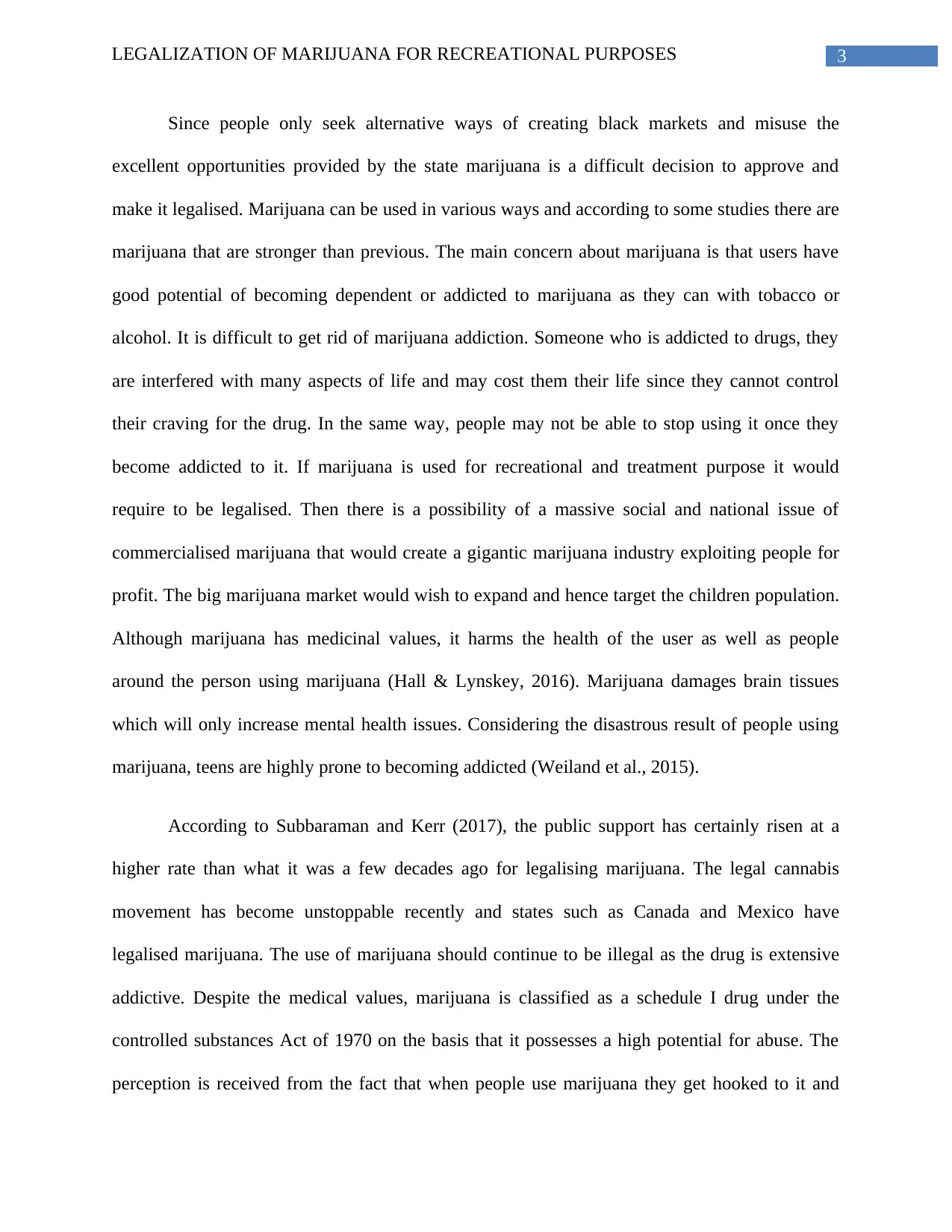
3LEGALIZATION OF MARIJUANA FOR RECREATIONAL PURPOSES
Since people only seek alternative ways of creating black markets and misuse the
excellent opportunities provided by the state marijuana is a difficult decision to approve and
make it legalised. Marijuana can be used in various ways and according to some studies there are
marijuana that are stronger than previous. The main concern about marijuana is that users have
good potential of becoming dependent or addicted to marijuana as they can with tobacco or
alcohol. It is difficult to get rid of marijuana addiction. Someone who is addicted to drugs, they
are interfered with many aspects of life and may cost them their life since they cannot control
their craving for the drug. In the same way, people may not be able to stop using it once they
become addicted to it. If marijuana is used for recreational and treatment purpose it would
require to be legalised. Then there is a possibility of a massive social and national issue of
commercialised marijuana that would create a gigantic marijuana industry exploiting people for
profit. The big marijuana market would wish to expand and hence target the children population.
Although marijuana has medicinal values, it harms the health of the user as well as people
around the person using marijuana (Hall & Lynskey, 2016). Marijuana damages brain tissues
which will only increase mental health issues. Considering the disastrous result of people using
marijuana, teens are highly prone to becoming addicted (Weiland et al., 2015).
According to Subbaraman and Kerr (2017), the public support has certainly risen at a
higher rate than what it was a few decades ago for legalising marijuana. The legal cannabis
movement has become unstoppable recently and states such as Canada and Mexico have
legalised marijuana. The use of marijuana should continue to be illegal as the drug is extensive
addictive. Despite the medical values, marijuana is classified as a schedule I drug under the
controlled substances Act of 1970 on the basis that it possesses a high potential for abuse. The
perception is received from the fact that when people use marijuana they get hooked to it and
Since people only seek alternative ways of creating black markets and misuse the
excellent opportunities provided by the state marijuana is a difficult decision to approve and
make it legalised. Marijuana can be used in various ways and according to some studies there are
marijuana that are stronger than previous. The main concern about marijuana is that users have
good potential of becoming dependent or addicted to marijuana as they can with tobacco or
alcohol. It is difficult to get rid of marijuana addiction. Someone who is addicted to drugs, they
are interfered with many aspects of life and may cost them their life since they cannot control
their craving for the drug. In the same way, people may not be able to stop using it once they
become addicted to it. If marijuana is used for recreational and treatment purpose it would
require to be legalised. Then there is a possibility of a massive social and national issue of
commercialised marijuana that would create a gigantic marijuana industry exploiting people for
profit. The big marijuana market would wish to expand and hence target the children population.
Although marijuana has medicinal values, it harms the health of the user as well as people
around the person using marijuana (Hall & Lynskey, 2016). Marijuana damages brain tissues
which will only increase mental health issues. Considering the disastrous result of people using
marijuana, teens are highly prone to becoming addicted (Weiland et al., 2015).
According to Subbaraman and Kerr (2017), the public support has certainly risen at a
higher rate than what it was a few decades ago for legalising marijuana. The legal cannabis
movement has become unstoppable recently and states such as Canada and Mexico have
legalised marijuana. The use of marijuana should continue to be illegal as the drug is extensive
addictive. Despite the medical values, marijuana is classified as a schedule I drug under the
controlled substances Act of 1970 on the basis that it possesses a high potential for abuse. The
perception is received from the fact that when people use marijuana they get hooked to it and
Paraphrase This Document
Need a fresh take? Get an instant paraphrase of this document with our AI Paraphraser
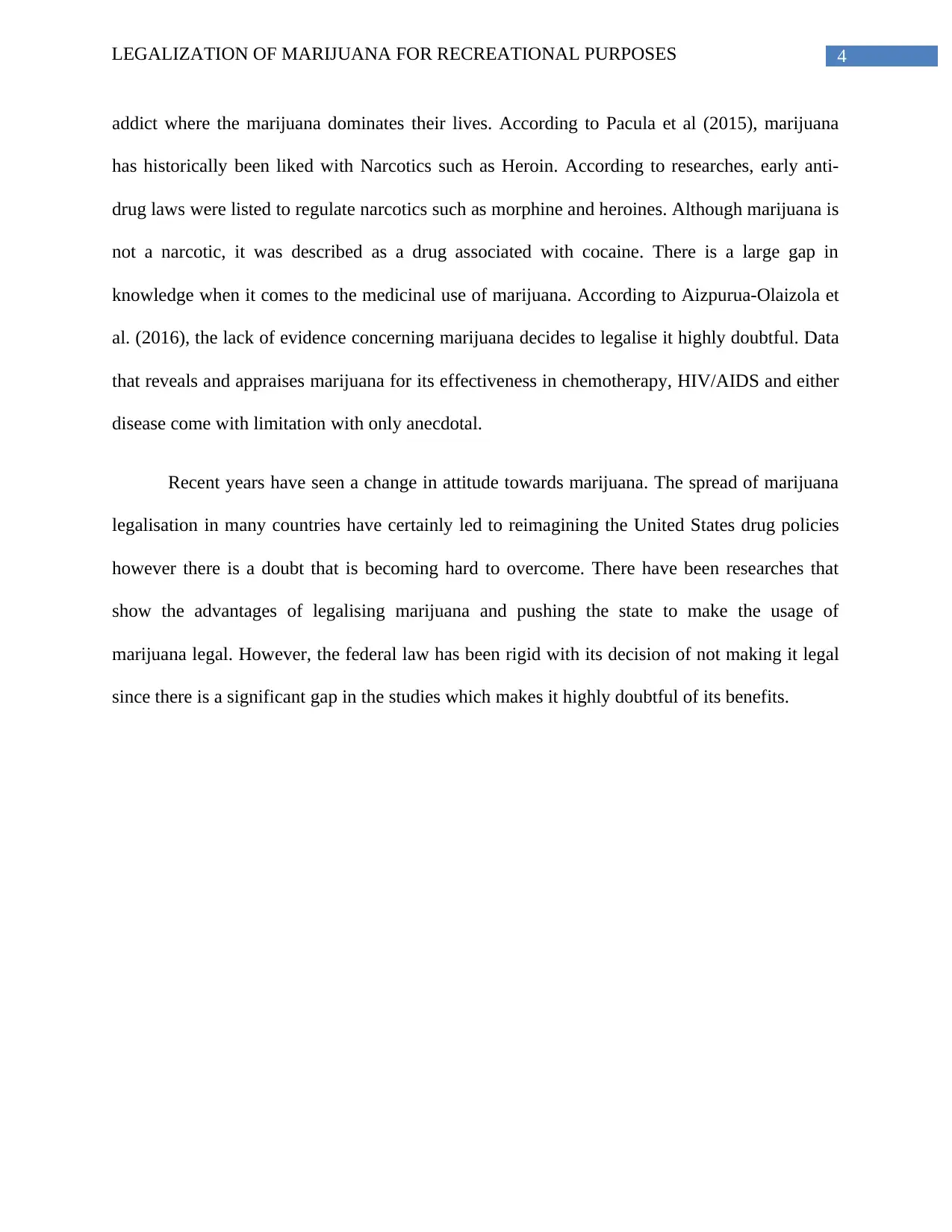
4LEGALIZATION OF MARIJUANA FOR RECREATIONAL PURPOSES
addict where the marijuana dominates their lives. According to Pacula et al (2015), marijuana
has historically been liked with Narcotics such as Heroin. According to researches, early anti-
drug laws were listed to regulate narcotics such as morphine and heroines. Although marijuana is
not a narcotic, it was described as a drug associated with cocaine. There is a large gap in
knowledge when it comes to the medicinal use of marijuana. According to Aizpurua-Olaizola et
al. (2016), the lack of evidence concerning marijuana decides to legalise it highly doubtful. Data
that reveals and appraises marijuana for its effectiveness in chemotherapy, HIV/AIDS and either
disease come with limitation with only anecdotal.
Recent years have seen a change in attitude towards marijuana. The spread of marijuana
legalisation in many countries have certainly led to reimagining the United States drug policies
however there is a doubt that is becoming hard to overcome. There have been researches that
show the advantages of legalising marijuana and pushing the state to make the usage of
marijuana legal. However, the federal law has been rigid with its decision of not making it legal
since there is a significant gap in the studies which makes it highly doubtful of its benefits.
addict where the marijuana dominates their lives. According to Pacula et al (2015), marijuana
has historically been liked with Narcotics such as Heroin. According to researches, early anti-
drug laws were listed to regulate narcotics such as morphine and heroines. Although marijuana is
not a narcotic, it was described as a drug associated with cocaine. There is a large gap in
knowledge when it comes to the medicinal use of marijuana. According to Aizpurua-Olaizola et
al. (2016), the lack of evidence concerning marijuana decides to legalise it highly doubtful. Data
that reveals and appraises marijuana for its effectiveness in chemotherapy, HIV/AIDS and either
disease come with limitation with only anecdotal.
Recent years have seen a change in attitude towards marijuana. The spread of marijuana
legalisation in many countries have certainly led to reimagining the United States drug policies
however there is a doubt that is becoming hard to overcome. There have been researches that
show the advantages of legalising marijuana and pushing the state to make the usage of
marijuana legal. However, the federal law has been rigid with its decision of not making it legal
since there is a significant gap in the studies which makes it highly doubtful of its benefits.
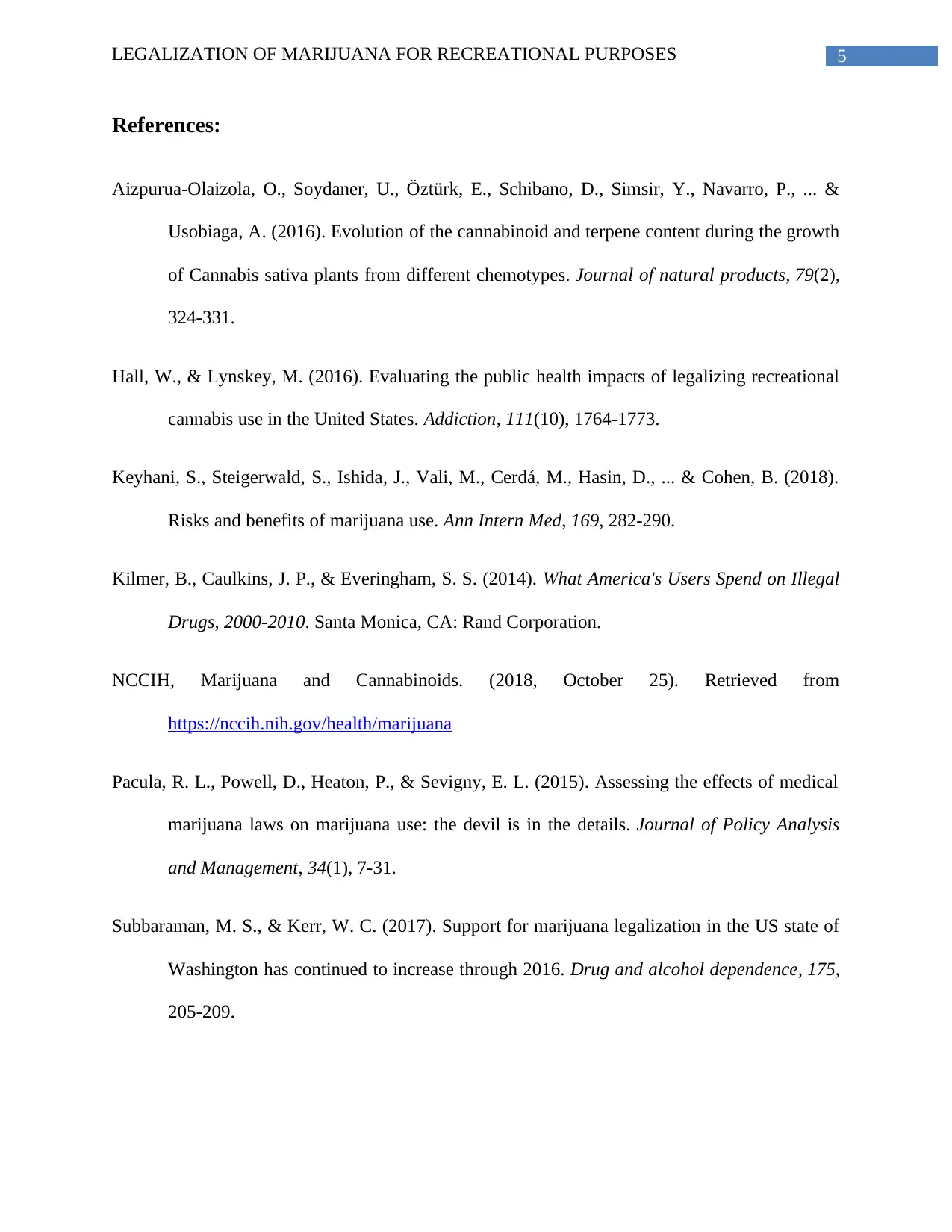
5LEGALIZATION OF MARIJUANA FOR RECREATIONAL PURPOSES
References:
Aizpurua-Olaizola, O., Soydaner, U., Ö ztürk, E., Schibano, D., Simsir, Y., Navarro, P., ... &
Usobiaga, A. (2016). Evolution of the cannabinoid and terpene content during the growth
of Cannabis sativa plants from different chemotypes. Journal of natural products, 79(2),
324-331.
Hall, W., & Lynskey, M. (2016). Evaluating the public health impacts of legalizing recreational
cannabis use in the United States. Addiction, 111(10), 1764-1773.
Keyhani, S., Steigerwald, S., Ishida, J., Vali, M., Cerdá, M., Hasin, D., ... & Cohen, B. (2018).
Risks and benefits of marijuana use. Ann Intern Med, 169, 282-290.
Kilmer, B., Caulkins, J. P., & Everingham, S. S. (2014). What America's Users Spend on Illegal
Drugs, 2000-2010. Santa Monica, CA: Rand Corporation.
NCCIH, Marijuana and Cannabinoids. (2018, October 25). Retrieved from
https://nccih.nih.gov/health/marijuana
Pacula, R. L., Powell, D., Heaton, P., & Sevigny, E. L. (2015). Assessing the effects of medical
marijuana laws on marijuana use: the devil is in the details. Journal of Policy Analysis
and Management, 34(1), 7-31.
Subbaraman, M. S., & Kerr, W. C. (2017). Support for marijuana legalization in the US state of
Washington has continued to increase through 2016. Drug and alcohol dependence, 175,
205-209.
References:
Aizpurua-Olaizola, O., Soydaner, U., Ö ztürk, E., Schibano, D., Simsir, Y., Navarro, P., ... &
Usobiaga, A. (2016). Evolution of the cannabinoid and terpene content during the growth
of Cannabis sativa plants from different chemotypes. Journal of natural products, 79(2),
324-331.
Hall, W., & Lynskey, M. (2016). Evaluating the public health impacts of legalizing recreational
cannabis use in the United States. Addiction, 111(10), 1764-1773.
Keyhani, S., Steigerwald, S., Ishida, J., Vali, M., Cerdá, M., Hasin, D., ... & Cohen, B. (2018).
Risks and benefits of marijuana use. Ann Intern Med, 169, 282-290.
Kilmer, B., Caulkins, J. P., & Everingham, S. S. (2014). What America's Users Spend on Illegal
Drugs, 2000-2010. Santa Monica, CA: Rand Corporation.
NCCIH, Marijuana and Cannabinoids. (2018, October 25). Retrieved from
https://nccih.nih.gov/health/marijuana
Pacula, R. L., Powell, D., Heaton, P., & Sevigny, E. L. (2015). Assessing the effects of medical
marijuana laws on marijuana use: the devil is in the details. Journal of Policy Analysis
and Management, 34(1), 7-31.
Subbaraman, M. S., & Kerr, W. C. (2017). Support for marijuana legalization in the US state of
Washington has continued to increase through 2016. Drug and alcohol dependence, 175,
205-209.
⊘ This is a preview!⊘
Do you want full access?
Subscribe today to unlock all pages.

Trusted by 1+ million students worldwide
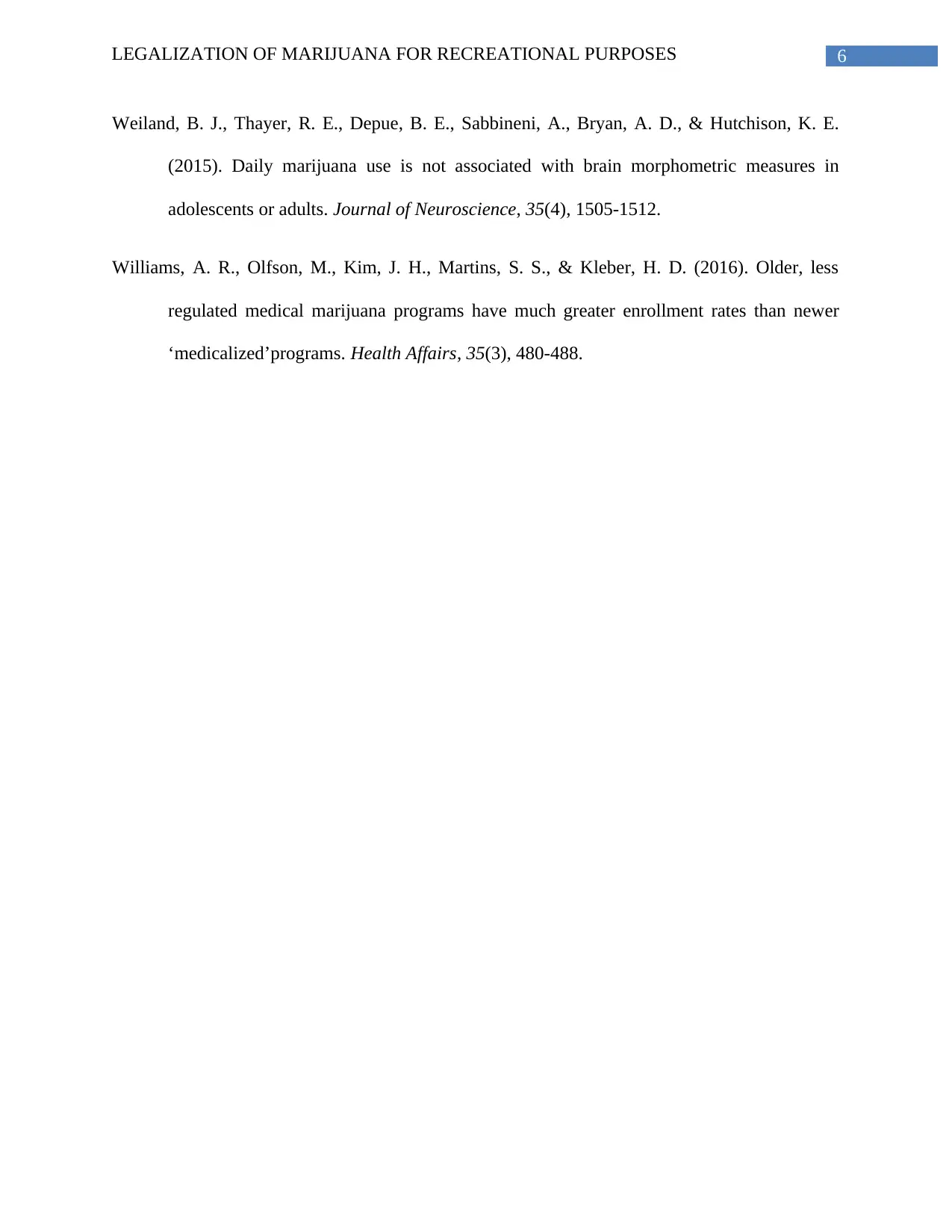
6LEGALIZATION OF MARIJUANA FOR RECREATIONAL PURPOSES
Weiland, B. J., Thayer, R. E., Depue, B. E., Sabbineni, A., Bryan, A. D., & Hutchison, K. E.
(2015). Daily marijuana use is not associated with brain morphometric measures in
adolescents or adults. Journal of Neuroscience, 35(4), 1505-1512.
Williams, A. R., Olfson, M., Kim, J. H., Martins, S. S., & Kleber, H. D. (2016). Older, less
regulated medical marijuana programs have much greater enrollment rates than newer
‘medicalized’programs. Health Affairs, 35(3), 480-488.
Weiland, B. J., Thayer, R. E., Depue, B. E., Sabbineni, A., Bryan, A. D., & Hutchison, K. E.
(2015). Daily marijuana use is not associated with brain morphometric measures in
adolescents or adults. Journal of Neuroscience, 35(4), 1505-1512.
Williams, A. R., Olfson, M., Kim, J. H., Martins, S. S., & Kleber, H. D. (2016). Older, less
regulated medical marijuana programs have much greater enrollment rates than newer
‘medicalized’programs. Health Affairs, 35(3), 480-488.
1 out of 7
Related Documents
Your All-in-One AI-Powered Toolkit for Academic Success.
+13062052269
info@desklib.com
Available 24*7 on WhatsApp / Email
![[object Object]](/_next/static/media/star-bottom.7253800d.svg)
Unlock your academic potential
Copyright © 2020–2025 A2Z Services. All Rights Reserved. Developed and managed by ZUCOL.





